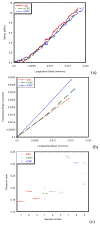Micro and nano MgO particles for the improvement of fracture toughness of bone-cement interfaces
- PMID: 23332232
- PMCID: PMC3594577
- DOI: 10.1016/j.jbiomech.2012.12.006
Micro and nano MgO particles for the improvement of fracture toughness of bone-cement interfaces
Abstract
The objective of this study was to determine whether inclusion of magnesium oxide (MgO) in micro and nanoparticulate forms in poly methyl methacrylate (PMMA) cement has any influence on the fracture toughness of bone-cement interfaces. An interfacial fracture mechanics technique was used to compare the values of fracture toughness (KIC) among bone-PMMA, bone-PMMA with micro MgO particles and bone-PMMA with nano MgO particles interfaces. This study found that the values of KIC of bone-PMMA with micro MgO particles and bone-PMMA with nano MgO particles interfaces were significantly higher when compared to the values of KIC of the bone-PMMA interface (p<0.0001). Results indicated that the addition of the micro and nano MgO particles to PMMA improved the quality of bone-cement union.
Copyright © 2012 Elsevier Ltd. All rights reserved.
Conflict of interest statement
The authors have no conflict of interest.
Figures





References
-
- ASTM. Annual book of astm standards: Section 3 - metals test methods and analytical procedures 03.01 1994
-
- Athanasiou KA, Zhu CF, Lanctot DR, Agrawal CM, Wang X. Fundamentals of biomechanics in tissue engineering of bone. Tissue Engineering. 2000;6:361–381. - PubMed
-
- Cowin SC. Bone mechanics handbook. 2001.
-
- Dundurs J. Edge-bonded dissimilar orthogonal elastic wedges under normal and shear loading. Journal of applied mechanics. 1969;36:650.
-
- Funk MJ, Litsky AS. Effect of cement modulus on the shear properties of the bone–cement interface. Biomaterials. 1998;19:1561–1567. - PubMed
Publication types
MeSH terms
Substances
Grants and funding
LinkOut - more resources
Full Text Sources
Other Literature Sources
Medical

